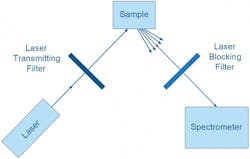Optimizing Biomedical Raman Spectroscopy with Advanced Optical Filters
Raman spectroscopy, enhanced with advanced filters, provides real-time data on biological tissues, holding immense potential in medicine, research, and biomedical engineering. By utilizing precise configurations and carefully chosen filters, Raman spectroscopy can deliver detailed information crucial for various biomedical and bio-analytical applications. The right laser wavelength and optimal filter choice are essential and vary depending on the biological sample being analyzed.
Understanding the Basics: How Raman Spectroscopy Works
Raman spectroscopy involves illuminating a sample with a laser beam and analyzing the resulting scattered radiation. This scattered light is divided into Rayleigh scattering (at the laser wavelength) and inelastic scattered light, known as the Raman signal. The Raman signal provides valuable information about the sample, while Rayleigh scattering, with its higher intensity, is filtered out using laser blocking filters (notch, edge pass, or band pass filters).
Historically, holographic gratings and multiple dispersion stages separated Raman scattering, which was then collected by photomultipliers. Today, advanced optics like notch or edge filters eliminate unwanted Rayleigh scatter, providing a clear Raman signal.

